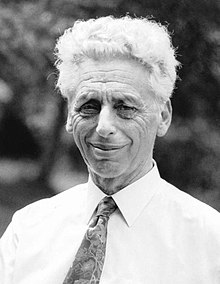Walter Haug
Walter Haug (born November 23, 1927 in Glarus ; † January 11, 2008 in Tübingen ) was a Swiss Germanic Medievalist .
Life
Walter Haug grew up in Walenstadt and attended grammar school in Schiers , where Kurt Ruh was his German teacher. He studied German , theater studies , philosophy and psychology at the universities of Zurich , Vienna and Munich . In 1952 he was in Munich with the dissertation “On the concept of the theatrical. Attempt an interpretation of Baroque theatricality starting from the drama of Andreas Gryphius " doctorate . Initially he worked as a dramaturge at theaters in Vienna and Munich. There he was successfully courted for an academic career by Hugo Kuhn in 1958, on the occasion of a gala performance for the 800th anniversary of the city . Subsequently, he worked as a lecturer in Munich, and in 1966 he received his habilitation with the thesis "Oriental-Medieval Literature Relations". A year later, Haug was appointed to the mediaeval professorship at the newly founded University of Regensburg . From 1973 (succeeding Wolfgang Mohr ) until his retirement in 1995, he was a full professor at the Department of Medieval Studies of the German Department of the University of Tübingen . He shared the subject there for 22 years in close cooperation with his colleague and friend Burghart Wachinger . Subsequently, he was a visiting professor at various universities in the United States of America and Germany.
Act
Haug's main areas of interest were Middle High German epics, comparative older literary history, literary theory and Western mysticism . He was a very prolific writer and most importantly an editor. Haug's literary theory in the German Middle Ages (WBG 1985) is one of the standard works of medieval studies.
In 1988 he was awarded the Gottfried Wilhelm Leibniz Prize together with Wachinger . With the money from the award, several conferences were held, the results of which were published in the 16-volume work "Fortuna Vitrea". In addition, Haug was editor of the 24-volume library of the Middle Ages and co-editor of the Bibliotheca Germanica and the journal German quarterly journal for literary studies and intellectual history (DVjs) .
A two-volume festschrift was published for Haug and Wachinger's 65th birthday, and a celebratory colloquium was held at the University of Tübingen for their 80th birthday.
Haug was a corresponding member of the Academy of Sciences in Göttingen and the Royal Netherlands Academy of Sciences and, since 1992, a full member of the Heidelberg Academy of Sciences .
Fonts
- The Otranto mosaic. Representation, interpretation and image documentation. Reichert, Wiesbaden 1977, ISBN 3-920153-73-1
- “The country from which nobody returns”. Myth, fiction and truth in Chrétien's “Chevalier de la Charrete”, in Ulrichs von Zatzikhoven's “Lanzelet” and in the “Lancelot” prose novel. Niemeyer, Tübingen 1978 (Studies on the History of German Literature, Vol. 21), ISBN 3-484-10310-8
- Literary theory in the German Middle Ages from the beginnings to the end of the 13th century. An introduction. Scientific Book Society, Darmstadt 1985 (German Introduction), ISBN 3-534-08830-1
- Early German and Latin Literature in Germany 800–1150. (Ed. With Benedikt Konrad Vollmann ), Deutscher Klassiker-Verlag, Frankfurt / Main 1991 (Library of the Middle Ages, Vol. 1; Library of German Classics, Vol. 62), ISBN 3-618-66010-3
- Middle Ages and early modern times. Transitions, upheavals and new approaches. (Ed.), Niemeyer, Tübingen 1999 (Fortuna vitrea, Vol. 16), ISBN 3-484-15516-7
- Tristan and Isold , Deutscher Klassiker Verlag, Berlin 2011 ISBN 978-3-618-66100-9
- The truth of fiction . Studies on secular and spiritual literature of the Middle Ages and the early modern period. Tübingen 2003.
Web links
- Literature by and about Walter Haug in the catalog of the German National Library
- Short biography on the website of the SWR
- Information on the 2007 Colloquium
- Walter Haug: Why doesn't Parzival understand what he hears and sees? Telling between the plot and the perspective of figures in Hartmann and Wolfram (PDF file; 634 kB)
| personal data | |
|---|---|
| SURNAME | Haug, Walter |
| BRIEF DESCRIPTION | Swiss Germanist |
| DATE OF BIRTH | November 23, 1927 |
| PLACE OF BIRTH | Glarus , Switzerland |
| DATE OF DEATH | January 11, 2008 |
| Place of death | Tübingen |
